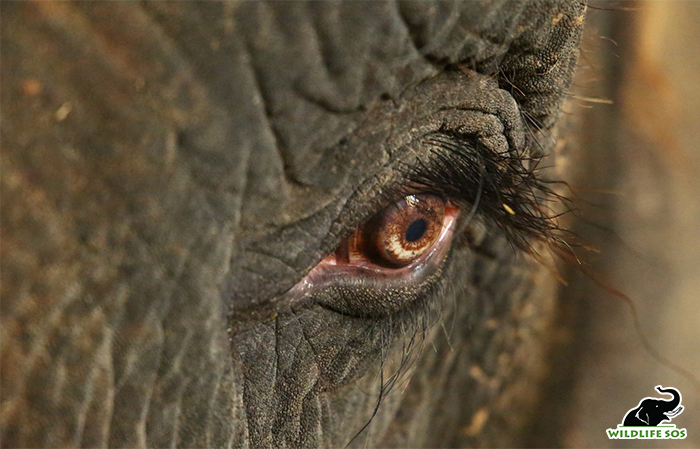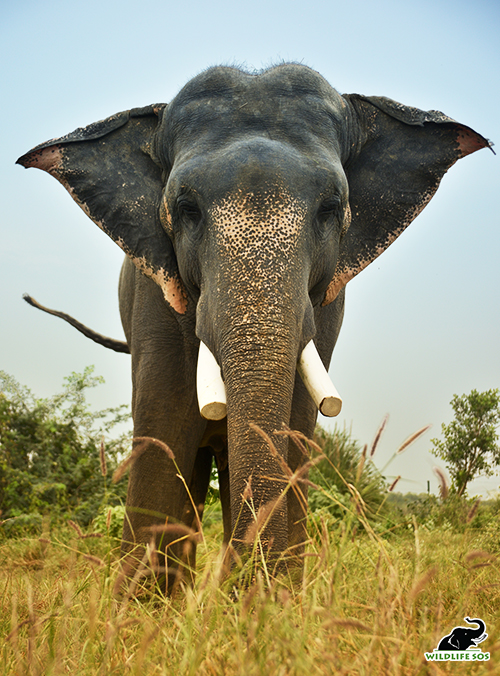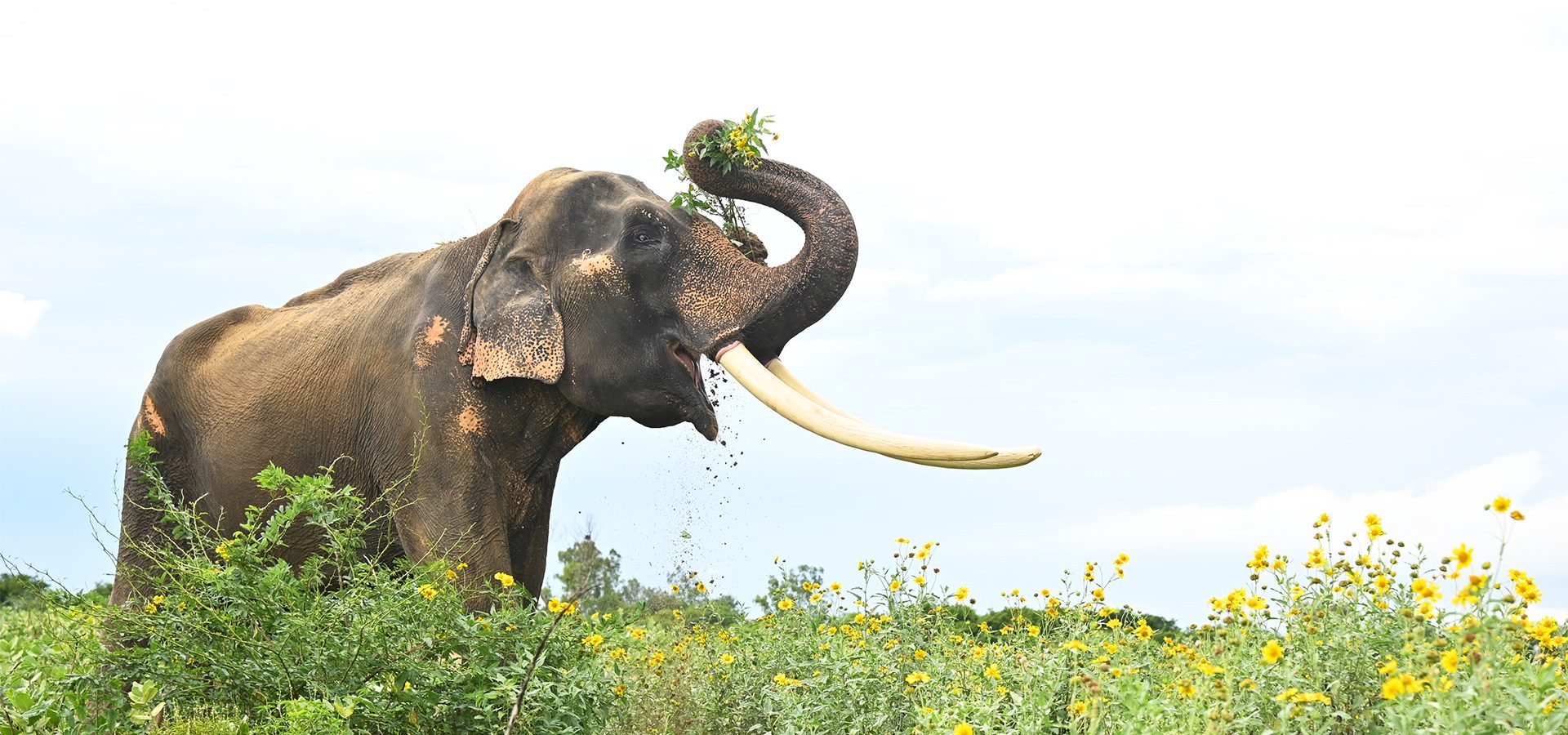The Wildlife SOS Elephant Conservation and Care Centre (ECCC) provides a safe haven for our majestic resident elephants. Here, they can employ their natural tendency to socialise and form close bonds with each other. What makes them further admirable is their astounding intelligence. The social aptitude of our resident elephants includes traits that are similar to humans such as empathy and problem-solving, and their demonstration of these makes for a fascinating spectacle. A remarkable attribute of this species is how they communicate effectively with one another. Let’s try and understand elephant communication, and what each of their techniques implies.
The Elephant Orchestra
Elephants utilise an array of sounds to express their emotions. For instance, elephants roar to convey intimidation or distress, and they chirp and squeak to gather their herd or even to provide reassurance.
Further, they make low-frequency rumbles to facilitate communication over vast expanses. They use these sounds to vocalise affection or their dominance, form connections, seek a partner, provide comfort, or offer encouragement to another. When elephants are highly stimulated, they like to trumpet. The loud trumpet call indicates excitement, anger, playfulness, or surprise, as well as a sense of being lost.
Look Into The Elephant’s Eye
Just like humans, elephants’ eyes display their moods and reactions. When elephants are excited, scared, or stressed, their eyes widen. This is due to the release of adrenaline, which prepares elephants and humans alike to handle perceived threats. When the elephant’s eyes are half-closed and its tail is swishing gently from side to side, one can tell that the elephant is in a relaxed mood. Did you know that just like humans and apes, elephants too can recognise themselves in a mirror? This was revealed in a study conducted with elephants in the Bronx Zoo in New York. The research was carried out keeping in mind that elephants have large and complex brains and indulge in frequent social interactions.

The Flapping of Giant Ears
Elephants have large ears with thin skin and prominent veins. These veins ensure that the body temperature of elephants is regulated. When flapped, the ears act like cooling fans for the elephants, and the several blood vessels present on their ears help to circulate the blood throughout their body.
When elephants in the wild are confronted by a potential enemy or predator, they may show their annoyance by extending their ears outwards at a 90-degree angle from their body to appear larger. The spreading of ears may also be seen when elephants feel excited, surprised, or alarmed.
Elephants And Their Feet
Elephants occasionally lift one of their feet and hold it still, or swing it back and forth. This behaviour is linked to their emotional state or uncertainty about how to proceed in a particular situation. Moreover, some field studies suggest that elephants use their feet to pick up seismic signals as well.
Elephants navigate their surroundings with a remarkable degree of silence, but there are moments when they deliberately scuff their feet against the ground to produce sound. This behaviour is a way to assert dominance or intimidate other elephants or animals around them. Elephants at ECCC can be seen scuffing or kicking the ground to loosen soil or grass, before they feed on the forage.
Shaking Heads
Shaking heads is a common way for elephants to reflect annoyance, frustration, dominance, or even joy. This behaviour can also be a warning to other elephants or potential threats. Additionally, elephants may shake their heads to dislodge insects or to remove water after bathing or swimming. However, it is key to note that the reason behind an elephant shaking its head can often be mistaken if the situation they are found in has not been considered. Captive elephants rescued from cruelty are prone to display stereotypic behaviour by bobbing and swaying their head, which are expressions of stress.
A Firm Stand
When feeling threatened by predators or humans, wild elephants may hold their heads high, raise their chins, and extend their ears while staring straight ahead over their tusks. They might even stand on a raised surface like a mud hill of dirt to heighten their intimidation factor. By adopting this stance, the elephant shows that it is alert and ready to react to any potential danger.

Trunk Tactics
An elephant’s trunk is not only a nose, but has many other functions that help the mammal! In times of hesitation or uncertainty, elephants twist the tip of their trunk back and forth. Take a look at this video featuring our resident elephants to discover some interesting facts about their trunks.
Staying Still
An elephant herd in the wild sometimes shows a fascinating behaviour that is called synchronised freezing, which means that all of them become motionless together. This happens when they use their keen senses of smell and hearing to detect any unusual sounds or smells in the environment especially to locate food. This behaviour is also particularly useful in areas with high predator activity, where the elephants need to be extra cautious.
Smart and Sensible
Elephants are impressive animals that use their trunks, tails, and feet skilfully. They can hone their problem-solving ability through trial and error. For instance, to swat flies, elephants residing at our centres have been seen using their ears and tails. They scratch their body against tree trunks to relieve an itch, manoeuvre their trunks to obtain food out of their feeder, or even take mud baths to prevent body heat. Elephants in the wild dig holes in the ground to access water, and to prevent it from evaporating, they rip barks from a tree, chew them into a ball, and use that to plug the dug hole!
The Kick-Starters
The younger elephants at our centre frequently engage in playful kicking with each other. It is normal for elephants to use these kicks to make other elephants move away, especially when they feel another elephant is standing too close to them or to claim the best spot. Additionally, elephants may kick objects like branches or vegetation for amusement or to intimidate other animals.
Caring Gestures
Elephants are social creatures. They display human-like traits such as sensitivity and care with soothing gestures of touching and caressing each other with their trunks. It is said that elephants never forget. They have been known to demonstrate deep mourning when a loved one dies, such as gently touching and caressing the deceased’s head and pausing in silence for several minutes at the location of their passing, even years after their death.
In the words of Canadian journalist Graydon Carter, “We admire elephants in part because they demonstrate what we consider the finest human traits: empathy, self-awareness, and social intelligence. But the way we treat them puts on display the very worst of human behaviour.”
Wildlife SOS remains committed to fulfilling its duty to safeguard and preserve these gentle giants. You too can support us in the urgent need to protect elephants that are being mistreated in the tourism industry. Sign our #RefuseToRide petition and share it widely.





